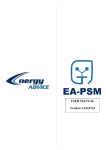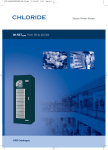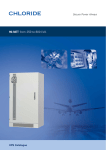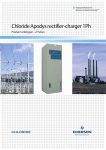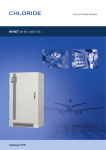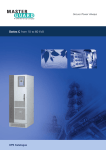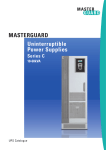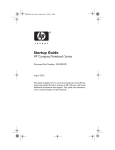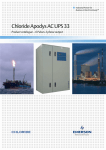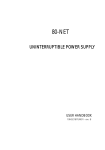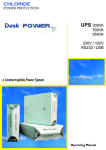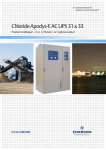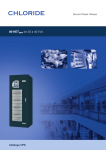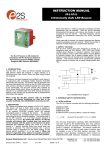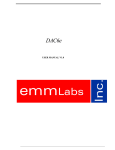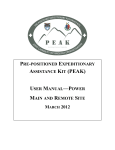Download Chloride80-NETUPS Systems from 60 to 500 kVA
Transcript
AC Power for Business-Critical Continuity™ Chloride 80-NET from 60 to 500 kVA UPS Catalogue Chloride80-NET UPS Systems from 60 to 500 kVA Chloride 80-NET UPS Systems from 60 to 500 kVA Scope 4 System Description 4 Device Description 5 General Requirements 8 AC/DC IGBT Converter (Rectifier) 9 DC/DC IGBT Converter (Booster/Battery Charger) 10 DC/AC IGBT Converter (Inverter) 12 Electronic Static Switch (Bypass) 14 Monitoring and Control, Interfaces 15 Mechanical Data 18 Environmental Conditions 18 Technical Data (60 to 120 kVA) 19 Technical Data (160 to 500 kVA) 23 Options 27 Parallel Configuration 29 3 Chloride80-NET UPS Systems from 60 to 500 kVA 1 Scope 2 System Description This specification describes a The single-line diagram of the UPS is shown in Figure 1. The system features double DSP and a micro-controller that provides the most powerful control in the UPS industry. The Vector Control technology will enhance the performance of these converters. In order to increase system redundancy, an independent electronic static bypass will be integrated into the UPS. By adding system components, CROSS switches, safety and disconnecting devices, system bypass switches, in addition to software and communications solutions, it will be possible to set up elaborate systems to ensure the complete protection of the loads. continuous duty three-phase, solid state, full IGBT (Insulated Gate Bipolar Transistor), double conversion uninterruptible power supply (UPS) system. The UPS will automatically provide continuity of electrical power, within defined limits and without interruption, 2.1 The system upon failure or degradation of the The UPS will provide high quality AC power for electronic equipment loads and will offer the following features: • Increased power quality • Full input Power Factor Correction (PFC) and very low THDi • Full compatibility with any TN and IT installation • Full compatibility with any standby power generator • Full compatibility with all types of loads with PF up to 1 without derating • Power blackout protection • Advanced battery care • Energy saving features • Transformer-free design (galvanic isolation transformer is available as integrated standard option) The UPS will automatically provide continuity of electrical power, within defined limits and without interruption, upon failure or degradation of the commercial AC source. The duration of autonomy (i.e. back up power time) in the event of network failure will be determined by the battery capacity. commercial AC source. The continuity of conditioned electric power will be delivered for the time period defined by the battery system. The rectifier, the inverter, and other mission critical converters within the UPS, are driven by patented Vector Control running on dedicated digital signal processor (DSP) systems. 2.2 Models available The Chloride 80-NET range will include the following three-phase input/ output models: MODEL Maintenance Bypass Bypass static switch Bypass Input IGBT Rectifier IGBT Inverter Primary Input Output Load Fuse Fuse Booster/Battery charger Battery Fuse Chloride LIFE®.net Basic signalling Battery Fuse Optional remote Connectivity (IP; SNMP; J-BUS;Etc.) Battery System Figure 1. Chloride 80-NET single-line diagram. 4 Rating (kVA) Chloride 80-NET/60 60 Chloride 80-NET/80 80 Chloride 80-NET/100 100 Chloride 80-NET/120 120 Chloride 80-NET/160 160 Chloride 80-NET/200 200 Chloride 80-NET/300 300 Chloride 80-NET/400 400 Chloride 80-NET/500 500 Chloride80-NET UPS Systems from 60 to 500 kVA 3 Device Description Chloride 80-NET is the result of an innovative research and development programme designed to offer users the most reliable power supply at a minimum cost and the highest possible energy conversion efficiency. 3.1 Components The UPS will consist of the following major components: • IGBT Rectifier • IGBT Battery Charger / Booster • IGBT Inverter • Dedicated digital signal processor (DSP) for each IGBT AC/DC, DC/AC converter • Micro-controller board for internal and external signal management • Electronic static switch and bypass supply • Manual maintenance bypass switch • Matching battery cubicles 3.2 Microprocessor control and diagnostics Operation and control of the UPS will be provided through the use of microprocessor- controlled logic. Indications, measurements and alarms, together with battery autonomy, will be shown on a graphic liquid crystal display (LCD). The procedures for start up, shutdown and manual transfer of the load to and from bypass will be explained in clear step-by-step sequences on the LCD display. 3.3 Intelligent double conversion operating modes Chloride 80-NET will adopt intelligent double conversion technology which allows the UPS to operate in double conversion or digital interactive mode according to the selected priority. The UPS will operate as follows: 3.3.1 Double Conversion Mode (DCM) 3.3.1.1 Normal (DCM) The UPS inverter continuously supplies the critical AC load. The rectifier derives power from the commercial AC source and converts it into DC power for the inverter and the battery charger. The battery charger keeps the battery in a fully charged and optimum operational condition. The inverter converts the DC power into clean and regulated AC power which is supplied to the critical load (conditioned line). The static switch monitors and ensures that the inverter tracks the bypass supply frequency. This ensures that any automatic transfer to the bypass supply (due to an overload etc.) is frequency synchronized and does not cause interruption to the critical load. 3.3.1.2 Overload (DCM) In the event of an inverter overload, manual stop or failure, the static switch will automatically transfer the critical load to the bypass line without interruption. 3.3.1.3 Emergency (DCM) Upon failure or reduction of the commercial AC source (see the Technical Data table for tolerances) the inverter will supply the critical load, drawing power from the associated battery through the battery Booster. There will be no interruption to the critical load upon failure, reduction or restoration of the commercial AC source. While the UPS is powered by the batteries, indications will be provided of actual autonomy time remaining as well the duration of the mains failure. 3.3.1.4 Recharge (DCM) Upon restoration of the commercial AC source, even where batteries are completely discharged, the rectifier will restart automatically (walk in) and gradually take over both the inverter and battery charger. This function will be fully automatic and will cause no interruption to the critical load. 5 Chloride80-NET UPS Systems from 60 to 500 kVA 3.3.2 Digital Interactive Mode (DIM) If priority has been set to digital interactive mode, intelligent double conversion technology will allow Chloride 80-NET to continuously monitor the condition of the input supply, including its failure rate, to ensure maximum reliability for critical users. On the basis of the analysis performed, it will decide whether to supply the load through the direct line or the conditioned line. This operational mode, which allows significant energy savings by increasing the overall AC/AC efficiency of the UPS, up to 98%, is primarily intended for general purpose ICT applications. However, it does not provide the same output power quality as when the UPS operates in double conversion mode. It will therefore be necessary to verify whether this mode is appropriate for special applications. Digital interactive mode is not available for parallel systems. 3.3.2.1 Normal (DIM) The operating mode will depend on the quality of the mains supply in the short-term past. If the line quality has remained within permitted tolerance parameters in this timeframe, the direct line will provide continuous supply to the critical AC load through the bypass static switch. The IGBT inverter control will remain in constant operation and synchronization with the direct line without driving the IGBT. This ensures that the load can be transferred to the conditioned line without any break in supply where there is a deviation from the selected input power tolerance levels. If the direct line failure rate has been outside permitted parameters, Chloride 80-NET will supply the load from the conditioned line. The battery charger supplies the energy necessary for maintaining maximum charge to the battery. 3.3.2.2 Inverter stop (DIM) If the inverter is stopped for any reason there is no transfer to the conditioned line and the load continues to be supplied by the direct line. The mains voltage and frequency values must be within the tolerance limits specified. 3.3.2.3 Overload (DIM) In the event of an overload with a duration in excess of the maximum capacity specified for the bypass static switch, the load is maintained on the direct line and a warning message on the LCD display will appear to warn the user about the potential risk related to this condition. This default behavior can be changed (via a Service accessible firmware setting) to force a load transfer to the conditioned line (similar to that described below), even if the bypass source is available. In the event of an overload in conjunction with an unsuitable bypass mains supply, Chloride 80-NET will transfer the load from the direct line to the conditioned line (assuming Chloride 80-NET was operating from the direct line) and the inverter will continue to supply the critical load for a period dependant on the 6 degree of the overload and the UPS features. Visual and audio alarms alert the user to the problem. 3.3.2.4 Emergency (due to mains supply failure or variance beyond tolerance limits, DIM) If Chloride 80-NET is supplying the load via the direct line and the bypass mains supply varies beyond tolerance levels (adjustable using the software), the load will be transferred from the direct line to the conditioned line. The load is powered from the mains via the rectifier and inverter, (provided the input mains remains within the tolerances stated in chapter 12 & 13). Should the input mains fall below the lower limit, the batteries will be used to power the load via the inverter. The user is alerted to the battery discharge by visual and audio alarms and the remaining autonomy is displayed on the LCD. During this process, it is possible to extend the remaining autonomy by switching off nonessential loads. 3.3.2.5 Return to normal conditions (DIM) When the mains supply returns to within tolerance limits, Chloride 80-NET will continue to supply the load via the conditioned line for a period of time dependant on the direct line failure rate (the conditioned line draws power from the mains not the battery). When the direct line has stabilized, Chloride 80-NET returns to normal operation. The battery charger automatically begins to recharge the battery so that maximum autonomy is guaranteed in the shortest possible time. Chloride80-NET UPS Systems from 60 to 500 kVA 3.3.3 Maintenance bypass The UPS will be fitted with an internal maintenance bypass switch which enables a load transfer to bypass supply. As a result, there will be no interruption to the power of the critical load when it is necessary to take the UPS out of service for maintenance or repair. Bypass isolation will be complete and all serviceable components such as fuses, power modules etc will be isolated. Transfer/retransfer of the critical load may be accomplished by automatic synchronisation of the UPS to the bypass supply and by paralleling the inverter with the bypass source before opening or closing the bypass switch as appropriate. 3.3.4 Operation without battery If the battery is taken out of service for maintenance, it has to be disconnected from the UPS by means of an external switch (e.g. situated in the battery cabinet). The UPS will continue to operate and meet the performance criteria specified with the exception of the battery backup time. 3.4 Control and diagnostics Control of the power electronics modules will be optimized in order to provide: • optimum three-phase supply of the load • controlled battery charging • minimum phase effects upon the supply network. Chloride 80-NET’s control platform incorporates double DSP and a microcontroller, allowing it to provide the most powerful control in the UPS industry. This platform combines the advantages of a double DSP which executes all the Vector Control algorithms and the Microcontroller which gives maximum communication flexibility whilst interfacing all internal and external signals. 3.4.1 Vector control To ensure the quick and flexible processing of measuring data, special arithmetic algorithms will be implemented in DSP, rapidly generating controlled variables as a result. This will thus render possible the real-time control of the inverter electronics, resulting in obvious advantages in the performance of the power components. These advantages will be: • Improvement of short circuit behaviour, as individual phases can be more quickly controlled • Synchronism or phase angle precision between UPS output and bypass supply even in the case of a distorted mains voltage • High flexibility in parallel operation: parallel blocks may be housed in separate rooms. Several algorithms included in the Vector Control firmware are covered by patents. 3.4.2 Redundancy, preventive monitoring In order to maximize the reliability of the system, the control unit will monitor a wide number of operating parameters for the rectifier, inverter and battery. All vital operating parameters, such as temperatures, frequency and voltage stability at the system input and output, load parameters and internal system values will be constantly monitored and controlled for irregularities. The system will react automatically before a critical situation arises either for the UPS or the load, in order to ensure the supply of the load even in these difficult conditions. 3.4.3 Telediagnosis and telemonitoring In all the above modes of operation, the UPS may be monitored and controlled from a remote location such as a service center, in order to maintain system reliability at nominal levels. Even during complete shutdown of the UPS, information relating to the operating parameters will not be lost thanks to non volatile FRAM which will store the information for up to 45 years. 7 Chloride80-NET UPS Systems from 60 to 500 kVA 4 General Requirements 3.4.4 Serviceability and commissioning The new Chloride 80-NET is designed for easy installation and serviceability thanks to the drawerdesign, making it a full modular service solution and considerably minimising the time needed for repairs. All functional modules can be removed by extracting the drawers from the front of machine. Each UPS will be equipped with ID card, including all UPS working parameters. This card, univocally related to the UPS, reduces the MDT to zero shortening service and commissioning operations. 4.1 Applied standards Emerson Network Power operates Quality Management Systems which comply with ISO 9001, as well as Environmental Policies and Management Systems that comply with ISO 14001. Chloride 80-NET will carry the CE mark in accordance with the Safety European Directive 2006/95 (superseding the 73/23 and successive amendments) and European EMC directive 2004/108 (superseding the 89/336, 92/31 and 93/68). Chloride 80-NET is designed and manufactured in accordance with the following international standards: • IEC/EN62040-1-1 general and safety requirements • EN62040-2 EMC requirements • IEC/EN62040-3 operating requirements. • Classification according to IEC/EN 62040-3: VFI-SS-111 4.2 Safety In terms of general and safety requirements, the UPS conforms to standard IEC/EN 62040-1-1 governing use in unrestricted access locations. 4.3 EMC and surge suppression Electromagnetic effects will be minimzed in order to ensure that computer systems and other similar electronic loads will neither be adversely affected by nor affect the UPS. The UPS will be designed to meet the requirements of EN 62040-2, class C3. The manufacturer and customer in partnership agree to ensure the essential EMC protection requirements for the specific resulting installation. 4.4 Neutral connection The Chloride 80-NET output neutral will be electrically isolated from the UPS chassis. The input and output neutral connections are the same, i.e. they are solidly tied together. Therefore the UPS will not modify the state of the upstream neutral, in any operating mode, and the neutral state of the distribution downstream from the UPS is imposed by the mains one. 4.5 Materials All materials and components including the UPS will be new and of current manufacture. 8 Chloride80-NET UPS Systems from 60 to 500 kVA 5 AC/DC IGBT Converter (Rectifier) 5.1 Primary input The three-phase current taken from the commercial AC source will be converted to a regulated DC voltage by the IGBT rectifier. In order to protect the power components within the system each phase of the rectifier input will be individually fitted with a fast-acting fuse. As shown in Figure 1, the IGBT rectifier will provide DC power to the DC/AC output converter (IGBT inverter) and to the DC/DC battery converter (booster / battery charger) when the latter is working in battery charger mode. 5.2 Total Input Harmonic Distortion (THD) and Power Factor (PF) The maximum voltage THD (THDV) permitted on the rectifier input (either from the utility or generator) will be 15% (normal operation is guaranteed up to 8%). The maximum current THD injected into the mains (THDI) will be less than 3% at maximum input power and input voltage THDV < 1% (nominal input voltage and current). The input power factor (PF) will be > 0.99. Under other input conditions and with other output load fractions the THDI will be < 5%. This means that the Chloride 80-NET will be seen by the primary mains sources and distribution as a resistive load (i.e. it will absorb only active power and the current waveform will be practically sinusoidal), thus ensuring total compatibility with any power source. Chloride 80-NET includes all the performances offered by load active filtering devices as standard. 5.3 Operation with diesel generator In order to obtain the required THD on input voltage, the coordination between a diesel generator and UPS will be based on the generator’s subtransient reactance, as opposed to its short-circuit reactance. 5.4 Soft start With the UPS logic properly powered, after applying the input voltage the rectifier starts an additional programmable current soft start (1-90 seconds). This procedure results in a gradual and soft walk-in of the current taken from the input voltage supply network. This ensures that any standby generator is gradually introduced into the UPS input, as shown in Figure 2. To avoid the simultaneous start-up of different rectifiers, it is possible to programme a hold-off dedicated start delay (1-180 seconds) for each unit. In addition, the UPS includes an ‘on generator’ function which, when activated via floating contact, provides the possibility of inhibiting either battery charging, synchronization of the inverter to the direct line supply or transfer to the direct line forcing the unit to work in double conversion mode. When the UPS is operating with a flywheel system, the corresponding Hold-off and Soft start parameters must be set according to the requirements of the gen set. Please contact technical support for more information. Hold-off Delay (1- 180s) AC Input Current Mains Failure Figure 2. Rectifier soft start. 9 Current soft start (1-90 s) Mains OK Time Chloride80-NET UPS Systems from 60 to 500 kVA 6 DC/DC IGBT Converter (Booster / Battery Charger) 6.1 Booster / Battery Charger As can be seen in Figure 1, this bidirectional IGBT DC/DC converter will have the following functions: • To recharge the batteries taking the power from the DC bus, when the primary input mains is within the given tolerances • To provide the suitable full DC power, taken from the batteries, to the IGBT output inverter if the primary mains is unavailable. 6.2 Battery charger mode This converter will be operable with the following types of batteries: • Sealed Lead Acid • Lead Acid (VRLA) • Ni - Cd The selection of the optimum charging method will be completely managed by the microprocessor. Several different charging methods are available. 6.3 Voltage regulation, temperature compensation In order to ensure optimum battery charging, float voltage will be automatically adjusted to the ambient temperature. The IGBT rectifier will be capable of supplying the battery charger with DC voltage at rated power, even if the UPS input AC voltage is below the nominal voltage specified. A further reduction of the input AC voltage (within specified limits) will inhibit the battery charger but will not require the discharging of the batteries. See Figure 3 for details. 6.4 Residual ripple filtering The battery charger output will have a residual voltage ripple of <1% RMS. 6.5 Capacity and charging characteristics When the primary mains is not Input Voltage vs Output Load Output Load P/Pn (%) P/Pn suitable to supply the rectifier, the DC/DC converter (booster mode) will provide the required power to the inverter using the energy stored in the battery. After the discharge of the battery and when the input AC power is restored, the rectifier will power the inverter and recharge the batteries through the DC/DC converter in battery charger mode. The following charging methods are an example of the several methods available, giving the possibility of matching the following different types of accumulators: 6.5.1 Sealed, maintenance-free lead acid accumulators: Charging is at constant current up to the maximum floating voltage level. Thereafter the voltage will be kept at a constant level within narrow limits (single-step charging method). 6.5.2 Sealed, low-maintenance lead acid accumulators or NiCd accumulators: Charging is at increased charging voltage and constant charging current (boost charge phase). When the charging current falls short of a lower threshold value the battery charger will automatically return to floating voltage level (two-step charging method). 6.6 Overvoltage protection Input Voltage (V) Figure 3. Input voltage in relation to the output load percentage. 10 The battery charger will automatically switch off if the DC battery voltage exceeds the maximum value associated with its operational status. Chloride80-NET UPS Systems from 60 to 500 kVA 6.7 Battery management Using advanced battery care (ABC) the Chloride 80-NET series will maximize battery running time by up to 50%. The main battery care features are described as follows. 6.7.1 Operating parameters When operating with a maintenance free, valve regulated lead acid battery (VRLA), the parameters per cell will be as follows: • End of discharge voltage (V) 1.65 • Shutdown imminent alarm (V) 1.75 • Minimum battery test voltage (V) 1.9 • Nominal voltage (V) 2.0 • Battery discharging alarm (V) 2.20 @ 20°C • Float voltage (V) 2.27 @ 20°C • High voltage alarm (V) 2.4 6.7.2 Automatic battery test The operating condition of the batteries will be automatically tested by the control unit at selectable intervals, e.g. weekly, fortnightly or monthly. A short-time discharge of the battery will be made to confirm that all the battery blocks and connecting elements are in good working order. In order to preclude a faulty diagnosis, the test, at the earliest, will be launched 24 hours after the latest battery discharge. The battery test will be performed without any risk to the load, even if the battery is completely defective. Users will be alerted to a detected battery fault. The battery battery life remaining, based on real operating conditions such as temperature, discharge and charging cycles, and discharge depth. test will not cause any degradation in terms of the battery system life expectancy. 6.7.3 Ambient temperature compensated battery charger The float voltage will be automatically adjusted as a function of the temperature in the battery compartment (-0.11% per °C) in order to maximize battery operating life. 6.7.6 Operations with shared battery bank Although this configuration is not recommended, it is possible to share a common battery bank between a maximum of two UPS connected in parallel (see chapter 15 for details about parallel systems). The automatic battery test (see 6.7.2) will be significant if the total system load (of the 2xUPS in parallel) is equal to or greater than 20% (based on the UPS default battery recharging values). In any case this configuration is not recommended due to the negative impact on the overall system reliability caused by the lack of redundancy of the battery banks. 6.7.4 Time compensated end of discharge voltage When the discharge time exceeds one hour, the shutdown voltage will be automatically increased, as shown in Figure 4 for VRLA, to avoid prolonged battery discharge as a result of a light load. 6.7.5 Remaining battery life Chloride 80-NET uses sophisticated algorithms to determine the Voltage per cell 1.80 1.75 1.70 1.65 0 1 2 3 4 5 6 7 8 Figure 4. End-of-discharge voltage in relation to discharge time. 11 9 10 Time (hours) Chloride80-NET UPS Systems from 60 to 500 kVA 7 DC/AC IGBT Converter (Inverter) 7.1 AC voltage generation 7.4 Total Harmonic Distortion From the DC voltage of the intermediate circuit the inverter will generate sinusoidal AC voltage for the user load on the basis of pulse-width modulation (PWM). By means of the digital signal processor (DSP) of the control unit, the IGBT of the inverter will be controlled so that DC voltage is divided up into pulsed voltage packets. Thanks to a low-pass filter, the pulse-width modulated signal will be converted into sinusoidal AC voltage. No isolation transformer is needed for the IGBT inverter, with the great benefits of: energy conversion efficiency, physical size and weight of the modules. The inverter will provide harmonic neutralization and filtering to limit the THD on the voltage to less than 1% with a linear load. For reference non-linear load (as defined by IEC/ EN62040-3) the THD will be limited to less than 3%. 7.5 Neutral sizing 7.2 Voltage regulation The inverter output voltage on the three phases will be individually controlled to achieve the following performances: 7.2.1 Steady state The inverter steady state output voltage will not deviate by more than ±1% in a steady state condition for input voltage and load variations within the quoted limits. The sizing of the inverter neutral will be oversized on all ratings in order to cope with the combination of harmonics on the neutral wire when driving singlephase reference nonlinear loads. The inverter neutral is sized x 1.7 in relation to the phase. 7.6 Overload 7.2.2 Voltage transient response The inverter transient voltage will not exceed Class 1 limits when subjected to application or removal of 100% load as defined by IEC/EN62040-3. 7.3 Frequency regulation The inverter output frequency will be controlled to achieve the following performances: 7.3.1 Steady state The inverter steady-state output frequency, when synchronized to bypass supply, will not deviate by more than ±1% adjustable to ±2%, ±3%, ±4%. 7.3.2 Frequency slew rate The frequency slew rate will be <1 Hz per second. 7.3.3 Frequency control The output frequency of the inverter will be controlled by a quartz oscillator which can be operated as a free running unit or as a slave for synchronized operation with a separate AC source. The accuracy of the frequency control will be ±0.1% when free-running. 12 The inverter will be capable of supplying an overload of 125% for 10 minutes and 150% for one minute of the nominal power. 7.7 Inverter shutdown In the event of an internal failure the inverter will be immediately shut down by the control unit. The UPS device or the parallel-operated UPS systems will continue to supply the load from the bypass supply without interruption, if it is within permissible limits. 7.8 Output voltage symmetry The inverter will guarantee the symmetry of the output voltages at ±1% for balanced loads and ±3% for 100% unbalanced loads. Chloride80-NET UPS Systems from 60 to 500 kVA temperatures, as shown in Figure 5. In the most common conditions (25°C) Chloride 80-NET will provide 10% more power than nominal. In these conditions the battery charge will be reduced correspondingly. The phase angle displacement between the three-phase voltages will be: • 120° ± 1° for balanced loads • 120° ± 3° for unbalanced loads (0, 0, 100%) 7.12 Symmetrical Power Factor Output Diagram 7.10 Short circuit The inverter short circuit capacity The full IGBT inverter is able to supply, without derating, all kinds of loads (leading and lagging) with a power factor up to 1. This behavior is achieved thanks to the perfect dimensioning of all components of the output stage, which allows the obtaining of a Power Factor output diagram perfectly symmetrical respect to the zero. Thanks to this feature, which is unique in the market, the Chloride 80-NET offers maximum flexibility and of Chloride 80-NET for the first 10ms will be 300% for any short circuit configuration. After the first 10ms, it will limit the current to 150% for no longer than than 5s and then it will shut down. 7.11 Automatic upgrade of inverter rated power The inverter will automatically upgrade its power as a function of ambient and operating compatibility with each installation and means that the customer doesn’t have to worry about future modifications of the loads with a different Power Factor. As it is shown in Figure 6, it is clearly evident from the two blue areas that every kind of load (leading or lagging) with PF up to 1 will be supplied by the UPS without any derating since the inverter will be able to work at 100% of its power. Output Power % % 100 KVAr 100% Leading KV A Cos φ 0.5 80 Cos φ 0.8 60 100% 40 110 0 KVA 20 25 50 75 Ambient Temperature 100 100% 20 105 40 Cos φ 0.9 Cos φ 0.8 60 Cos φ 0.6 80 15 25 30 40 C° 100 Cos φ 0.9 KVA 7.9 Phase displacement K 100% VA Lagging Figure 5. Automatic power upgrade. Figure 6. Power Factor Output Diagram. 13 Chloride80-NET UPS Systems from 60 to 500 kVA 8 Electronic Static Switch (Bypass) 8.1 General The bypass static switch will be a fully rated, high speed, solidstate transfer device and rated for continuous duty operation. The following transfer and retransfer operations will be provided by the electronic static switch: • Uninterrupted automatic transfer to the bypass supply in the event of: - inverter output overload - battery voltage outside limits in backup mode - over-temperature - inverter failure • If inverter and bypass supply are not synchronized at the time of a necessary transfer, a switching delay can be set to protect the critical load. This prevents possible damage to the load by unintentional phase shift. A delay of 20ms will be preset as a standard value. • Uninterrupted manual transfer/ retransfer to and from the bypass supply will be initiated from the control panel. • Uninterrupted automatic transfer/ retransfer to and from the bypass supply by activation of the digital interactive mode. • Uninterrupted automatic retransfer from the bypass supply, as soon as the inverter regains the capacity to supply the load. • The uninterrupted transfer from the inverter to the bypass supply will be inhibited in the following situations: - bypass supply voltage outside limits - failure of electronic bypass switch • The uninterrupted automatic retransfer may be inhibited in the following situations: - manual switching to bypass supply via the maintenance switch - UPS output overload - frequency converter. 8.1.1 Voltage The nominal voltage of the bypass line will be 230/400 VRMS. Any transfer from inverter to bypass line will be inhibited if the voltage is beyond a limit of ±10% (standard setting) of the nominal voltage. 8.1.2 Transfer time (double conversion) The switching time for a transfer from the inverter to the bypass supply or vice versa will be less than 0.5ms when synchronized. The system will ensure that the inverter is stable and operating normally before permitting a retransfer of the load back to inverter. The transfer time when out of synchronization will be defined by a preset parameter to prevent damage to the load by phase reversal. 8.1.3 Overload The bypass static switch will be capable of supporting the following overloads: 125% for 10 minutes 150% for 1 minute 700% for 600 milliseconds 1000% for 100 milliseconds 8.1.4 Manual maintenance bypass It will be possible to implement a manual uninterrupted bypass of the complete system in order to enable maintenance work to be carried out on the system. The bypass supply 14 will continue to feed the load. In this case the UPS will be voltagefree as it will be disconnected from the supply networks. In this case, maintenance work on the UPS can be carried out without affecting the connected electric load. 8.2 Backfeed protection When the UPS bypass input line is powered off, there is normally no dangerous voltage/current/power present on the UPS bypass input. However, when there is a fault in the bypass static switch (short circuit) there is the risk that electric power appears on the UPS bypass input terminals. In this case the inverter powers the critical load and the upstream input power line. This unexpected dangerous power can propagate in the upstream distribution through the faulty bypass line. Backfeed protection is a safety device which prevents any potential risk from electric shock on the UPS bypass input AC terminals, in the event of a failure of the bypass static switch SCR. The control circuit will include a contact (available for the user) which activates an external isolating device, such as an electromechanical relay or a tripping coil, upon backfeed detection. In compliance with IEC/EN 620401-1, the external isolating device is not included in the UPS. The external isolating device will be a 4 pole (3 phases plus neutral) air gap isolator and will be defined according to clause 5.1.4 of the previously cited standard. Chloride80-NET UPS Systems from 60 to 500 kVA 9 Monitoring and Control, Interfaces 9.1 General The UPS will incorporate the necessary controls, instruments and indicators to allow the operator to monitor the system status and performance, and take action where appropriate. Furthermore, interfaces allowing extended monitoring and control, in addition to service functions, will be available. 9.2 Touch screen display The control panel of the Chloride 80-NET includes a touch screen display for complete UPS monitoring and control. The main page of the touch screen displays a single-line diagram of the UPS along with the input and output measurements and information indicating the system status. The system status is indicated by three different icons; the tick icon indicates when the status is normal (OK), the triangle icon notifies of a system warning and the cross icon is activated when a fault is present. Below the single-line diagram there are four command buttons; one for starting and another for stopping the inverter, one for resetting faults (this becomes red when there is a system fault), and a buzzer/mute button for silencing/activating the acoustic signal in the case of an alarm (for details see Figure 7). Below these four commands there are six navigation buttons which each link to a dedicated information page: Events log: displays the date and time of important UPS events, alarms and other warnings. Measurements: this page holds the full set of measurements for each functional block (rectifier, bypass, booster/charger, batteries, inverter and load). Battery: displays the battery status/values including temperature, cell voltage, capacity and run time as well as commands for allowing the user to configure battery testing. LIFE: contains information about the status of the LIFE®.net connections, calls and call types. Tools: this page allows users to customize the settings of the touch screen display and to select the desired language. Each of these sub pages is programmed to revert back to the main page after 30 seconds of inactivity. The text displayed by the touch screen will be available in 15 languages: English, Italian, French, German, Spanish, Portuguese, Turkish, Polish, Swedish, Norwegian, Finnish, Czech, Russian, Arabic and Chinese, all selectable by the user. 9.2.1 Start and Stop buttons The touch screen display features two separate buttons for starting and stopping the inverter. The start/stop control incorporates a safety feature for preventing inadvertent operation. In fact, when selecting the start or stop functions for the inverter a pop-up window will appear asking for confirmation of the action selected. This pop up feature will be implemented for every command that results in a permanent change being made to the UPS settings. “Menu Up” button “Select Right” button Warning/fault: this page contains information regarding various anomalies concerning power converters such as the bypass, rectifier, inverter and booster charger. In addition to this there is also warning and fault information relating to the battery and the load. “Inverter OFF” button “Fault” LED (red) Flashes if FAULT condition message is present “Reset” button Figure 7. Touch screen display for Chloride 80-NET 60 to 500 kVA. 15 Chloride80-NET UPS Systems from 60 to 500 kVA 9.2.2 General Status symbols Three status indicators will render it possible to obtain a quick, general understanding of the status of the UPS, as described below: OK Green tick Normal Operation When the green tick status appears it shows that the system is running normally and neither warnings nor alarms are present. During mains failures (all other conditions being at nominal level), this tick is replaced by the yellow triangle. Warning Yellow triangle Warning Condition(s) present This indication will be activated by the presence of anomalous conditions, which could affect the nominal functioning of the UPS. These conditions do not originate with the UPS, but may be caused either by the surrounding environment or by the electrical installation (mains side and load side). It will be possible to read the description of the active warning(s) by clicking on the yellow triangle or via the warning and fault button at the bottom of the page. Fault Alarm Red circle with white cross Alarm Condition When the red circle with white cross appears, immediate attention should be given to the severity of the alarm, and service should be called promptly. It will be possible to read the description of the active alarm(s) by clicking on the warning and fault button at the bottom of the page. 9.3 Interface 9.3.1 Ethernet RJ45 Interface (X9) The Chloride 80-NET will be equipped with a RJ45 Ethernet interface. This interface is a 10/100 MBit autonegotiation full/half duplex RJ45 Ethernet interface for LAN communication with service software PPVis. It allows the setup of UPS parameters during commissioning and maintenance. 9.3.2 RS232 Service port (X3) The Chloride 80-NET will be equipped with one D type female connector with 9 pins for serial RS232 communication. Its purpose is for service only. 9.3.3 LIFE®.net (X6) The service Interface is a SUB-D 9 pin male connector for RS232 serial communication. The Chloride 80-NET has the slot (XS6) available for the LIFE®.net slot modem. If this slot modem is not installed, this port may be used for an external LIFE®.net kit (e.g. LIFE® over IP, GSM). 9.3.4 Slot card bay (XS3 & XS6) The Chloride 80-NET will be equipped with two slot bays, available for communication card options. One of the slots (XS6) will be available for the LIFE®.net slot modem. The other slot (XS3) will be available for connectivity options, such as ManageUPS NET III adapter. Please refer to Connectivity Solutions for further details about the available slot expansion cards. 16 Chloride80-NET UPS Systems from 60 to 500 kVA 9.3.5 2*16 Pole screw connector for input and output contacts (TB1) This 2*16-pole screw connector allows the connection of: six individual configurable output and four individual configurable input contacts which can be programmed via PPVis (service software tool) for a wide set of functions. This interface is SELV-isolated from the UPS primary circuits. The maximum rating of the output contacts must not exceed 24V and 1A (refer to the User Manual for further details). 9.3.6 LIFE®.net In order to increase the overall availability of the system, Chloride 80-NET will be delivered with the LIFE®.net communication kit, providing connection to LIFE®.net diagnostic service. LIFE®.net will allow the remote diagnosis of the UPS through the IP connection (Internet connection), telephone lines or GSM link in order to ensure maximum availability of the UPS throughout its operational life. The monitoring will be a real 24-hour, 365 day service thanks to a unique feature that allows trained Service Engineers to remain in constant electronic contact with the service center, and therefore the UPS. The UPS will automatically dial up the service center at defined intervals to provide detailed information that will be analyzed in Output Contacts (lower row of the connector): PIN PIN 1 (left) PIN 2 PIN 3 PIN 4 PIN 5 PIN 6 PIN 7 PIN 8 PIN 9 PIN 10 PIN 11 PIN 12 PIN 13 PIN 14 PIN 15 PIN 16 Status Normally closed Normally open Normally closed Normally open Normally closed Normally open Normally closed Normally open Common to PIN1-PIN8 N/A Normally closed Normally open Common to PIN11-PIN12 Normally closed Normally open Common to PIN14-PIN15 Preset Value Summary Alarm Bypass Active Low Battery AC Fail N/A N/A Selectable N/A Selectable N/A Input Contacts (upper row of the connector): PIN Status PIN 1 (left) Input 1 (24 VDC OUT) PIN 2 Input 1 (24 VDC signal) PIN 3 Input 2 (24 VDC OUT) PIN 4 Input 2 (24 VDC signal) PIN 5 Input 3 (24 VDC OUT) PIN 6 Input 3 (24 VDC signal) PIN 7 Input 4 (24 VDC OUT) PIN 8 Input 4 (24 VDC signal) PIN 9-16 N/A Preset Value Selectable Selectable Selectable Selectable N/A TB1 connector: the Interface is SELV - isolated from UPS primary circuits. 17 order to predict near term problems. In addition, it will be possible to control the UPS remotely. The communication of UPS data to the LIFE® Command Center will be transmitted in the following conditions : • ROUTINE: settable at intervals of between five minutes and two days (typically once a day) • EMERGENCY: when a problem occurs or parameters are beyond tolerance limits • MANUAL: following a request from the command center During the call the command center will: • Identify the UPS connected • Request the data stored in the UPS memory since the last connection • Request real-time information from the UPS (selectable) The service center will analyze historical data and issue a regular detailed report to the customer informing him of the UPS operational condition and any critical states. The LIFE®.net center allows the possibility of activating the LIFE®SMS delivery system option, where the customer may receive SMS notification which will be activated in the event of one of the following: • Mains power failure • Mains power recovery • Bypass line failure • Load supplied by reserve. Chloride80-NET UPS Systems from 60 to 500 kVA 10 Mechanical Data 10.1 Enclosure The UPS will be housed in a spacesaving modular enclosure with front doors and removable panels (protection as standard to IP 20). The enclosure will be made of zintec coated sheet steel and the doors will be lockable. 10.2 Ventilation Forced redundant air cooling will ensure that all the components are operated within their specification. Airflow will be controlled according to load demand. The UPS will also be capable of preserving normal operations even with one cooling fan out of operation (due to a failure) with 70% of the output nominal load @ 25°C ambient temperature. If these conditions are not met (with one fan failed), the UPS will supply the load through the static bypass if an overheating of the converters occurs. The failed fan condition will be immediately notified by the UPS through all the user interfaces and through the LIFE®.net service. The cooling air entry will be on the front and the air exit at the top of the device. The enclosure will be installed with at least 500 mm of free space between the device and roof of the enclosure in order to allow cooling air to exit unhindered. 10.3 Cable entry From 60 to 120kVA Cable entry will be from the bottom or side of the cabinet. Top cable entry will be available as an option. From 160 to 500kVA Cable entry, as standard, will be from the top, bottom or side. 11 Environmental Conditions The UPS will be capable of withstanding any combination of the environmental conditions listed below. It will operate without mechanical or electrical damage or degradation of operating characteristics. 11.3 Altitude The maximum altitude without derating will be 1000 metres above sea level (for higher altitudes Chloride 80-NET complies with IEC/EN 62040-3). 11.1 Ambient temperature Maximum daily temperature (24 hr) 40°C. 11.2 Relative humidity Up to 95% (non condensing) for temperature of 20°C. 18 10.4 Enclosure design All surfaces of the enclosure will be finished with an electrostatically applied epoxy coat. The coating will have a thickness of at least 60 microns. Standard colour of the enclosure will be RAL 7016. 10.5 Access to integrated subassemblies All internal subassemblies will be accessible for typical and most frequent maintenance from the front of the unit via hinged doors. Rear access will not be required for installation or servicing. The UPS will be forkliftable from the side after the removal of the bottom trim panels. Chloride80-NET UPS Systems from 60 to 500 kVA 12 Technical Data (60 to 120 kVA) UPS Unit 60 80 100 120 12.1 Primary input Nominal voltage(4) (V) 400 (3Ph + N(4)) Nominal Frequency (Hz) 50 (60 selectable), +/- 10% Input voltage range without battery discharge (V) 250(5) to 460 Power factor @ nominal load & nominal input conditions(2) ≥0.99 Input current distortion @ nominal input conditions & max input current(2) (6) (%) Walk in/Soft start Rectifier Hold-Off (seconds) (seconds) <3 10 (1 to 90 selectable) 1 (1 to 180 selectable) Inrush current / Imax input ≤1 12.2 Battery Permissible battery voltage range (V) 396 to 700 Recommended no. of cells: - VRLA - WET - NiCd 240 - 300 240 - 300 375 - 468 DC/AC efficiency on battery operation @ nominal load (%) Float voltage for VRLA @ 20°C (V/cell) 2.27 End cell voltage for VRLA (V/cell) 1.65 95.7 95.7 Float voltage temperature compensation 95.9 95.9 -0.11% per °C DC ripple current in float mode for a 10 min autonomy as per VDE0510 ≤0.05C10 Float voltage stability in steady state condition (%) ≤1 DC ripple voltage without battery (%) ≤1 Optimum battery temperature (°C) 15 to 25 Battery recharge current setting range for 240 cells @ 400V input voltage & nominal output load (PF=0.9) (A) Up to 17 Up to 22 Up to 30 Up to 35 Battery recharge current setting range for 264 cells @ 400V input voltage & maximum output load (PF=1) (A) Up to 6 Up to 7 Up to 10 Up to 12 Battery output power in discharge mode with nominal output load (kW) 56.7 75.6 94.4 113.3 End battery voltage for 240 cells (V) End battery current for 240 cells with nominal output load (A) 238 286 396 143 19 191 Chloride80-NET UPS Systems from 60 to 500 kVA UPS Unit 60 80 100 120 12.3 Inverter output Apparent nominal power @40°C ambient temperature, lagging or leading load PF (kVA) 60 80 100 120 Nominal active power (kW) 54 72 90 108 Nominal output current (A) 87 116 145 174 Maximum active power up to 100% of nominal apparent power(7) (kW) 60 80 100 120 Overload at nominal output voltage for 10 minutes(8) (%) 125 Overload at nominal output voltage for 1 minute(8) (%) 150 Short circuit current for 10ms/ <5s (%) 300/150 Nominal output voltage (V) 400 (380/415 selectable, 3ph+N) Nominal output frequency (Hz) 50 (60 selectable) Voltage stability in steady state condition for input (AC & DC) variations and step load (0 to 100%) (%) ±1 Voltage stability in dynamic condition for input variations (AC & DC) and step load (0 to 100% load and vice versa) (%) Complies with IEC/EN 62040-3, Class 1 Voltage stability in steady state for 100% load imbalance (0, 0, 100) (%) ±3 Output frequency stability - synchronized with bypass mains - synchronized with internal clock (%) (%) ±1 (2, 3, 4 selectable) ±0.1 Frequency slew rate (Hz/sec) <1 Output voltage distortion with 100% linear load (%) <1 Output voltage distortion @ reference non linear load as for IEC/EN 62040-3 (%) <3 Load crest factor handled without derating the UPS (Ipk/Irms) 3:1 Phase angle accuracy with balanced loads (degrees) 1 Phase angle accuracy with 100% unbalanced loads (degrees) <3 Neutral conductor sizing Nominal output power upgrading with ambient temperature: - At 25°C - At 30°C - At 40°C 1.7 nominal current (%) (%) (%) 110 105 100 20 Chloride80-NET UPS Systems from 60 to 500 kVA UPS Unit 60 80 100 120 12.4 Static bypass Nominal voltage (V) Nominal frequency (Hz) 50/60 (selectable) Frequency range (%) ±1 (2, 3, 4 selectable) Voltage range (%) ±10 (5 to 15 selectable) Maximum overload capacity(8) - For 10 minutes - For 1 minute - For 600 milliseconds - For 100 milliseconds (%) (%) (%) (%) 125 150 700 1000 SCR 400 (380/415 selectable, 3ph+N) I2t @ Tvj=125°C 8.3-10ms ITSM @ Tvj=125°C 10ms 80000 A2s 125000 A2s 4000 A 5000 A Transfer time with inverter synchronous to bypass: - Inverter to Bypass - Bypass to Inverter (ms) (ms) no break no break Transfer time with inverter not synchronous to Bypass (ms) <20 12.5 System data AC/AC efficiency VFI without charging current @ nominal input conditions(1) (2) with resistive load: - 25% load - 50% load - 75% load - 100% load AC/AC efficiency VFD without charging current @ nominal input conditions(1) (2) with maximum resistive load VFI Heat dissipation at nominal input conditions and max output load: - Float - Recharge mode VFD Heat dissipation at nominal input conditions and max output load (%) (%) (%) (%) 93.0 94.4 94.5 94.5 (%) 93.2 94.7 95.0 95.0 93.3 95.0 95.0 95.0 98.3 (kW) (Btu/h) 3.5 10723 4.7 14298 5.3 16162 6.3 19395 (kW) (Btu/h) 3.7 12458 4.8 16544 5.5 18856 6.6 22570 1.2 1.6 2 2.4 (kW) Noise @ 1 metre as per ISO 3746 (dBA ± 2dBA) 62 Protection degree with open doors Mechanical dimensions: - Height - Width - Depth 93.0 94.5 94.6 94.5 65 IP20 (higher degree of protection available on request) (mm) (mm) (mm) 1780 570 858 No. of cabinets 1780 845 858 1 7016 Frame color (RAL scale) Weight (kg) 290 Floor area (m2) 0.47 0.7 Floor loading (kg/m2) 613 570 400 Cable entry Bottom/Side Access Front and Top Forced ventilation with redundancy Cooling (m3/h) 802 21 1088 Chloride80-NET UPS Systems from 60 to 500 kVA UPS Unit 60 80 100 120 12.6 Environmental Location Indoor (free from corrosive gases and conductive dust) Operating temperature (°C) Maximum relative humidity @ 20°C (non condensing) (%) Max altitude above sea level without derating (m) (3) 0 - 40 Up to 95% 1000 (for higher altitudes complies with IEC/EN 62040-3) Immunity to electrical interference IEC/EN 62040-2 EMC Class 1) 2) 3) 4) 5) 6) 7) 8) IEC/EN 62040-2 Class C3 For tolerances see IEC/EN 60146-1 or DIN VDE 0558. The data refers to 25°C ambient temperature. At nominal voltage and frequency. Recommended average daily ambient temperature 35°C with a maximum of 40°C for 8 hours as requested for 62040 standard. In the case of a split input configuration, the primary input and the bypass input must have a common neutral. The neutral conductor may be connected only to the bypass or to primary mains, but it must be present (bypass and primary neutrals are connected inside the UPS). Referred to 70% of nominal load. With input voltage at nominal value and voltage distortion THD 1%. Nominal apparent power loads with PF > 0.9 can be supplied with marginal limitation of other performances. Please contact Technical Support team for further information. In case of different levels of overload refer to the specific overload curve. General conditions for the Technical Data table: The data shown are typical and not definable in other ways; furthermore the data refer to 25°C ambient temperature and nominal output power where not specified. Not all the data shown apply simultaneously and may be changed without prior warning. Data apply to the standard version, if not otherwise specified. If options are added, the data shown in the Technical Data Table may vary. For test conditions and measurement tolerances not specified in the table refer to the Witness Test Report procedure. 22 Chloride80-NET UPS Systems from 60 to 500 kVA 13 Technical Data (160 to 500 kVA) UPS Unit 160 200 300 400 500 13.1 Primary input Nominal voltage(4) (V) 400 (3Ph + N(4)) Nominal Frequency (Hz) 50 (60 selectable), +/- 10% Input voltage range without battery discharge (V) 250(5) to 460 Power factor @ nominal load & nominal input conditions(2) ≥0.99 Input current distortion @ nominal input conditions & max input current(2) (6) (%) Walk in/Soft start Rectifier Hold-Off (seconds) (seconds) <3 10 (1 to 90 selectable) 1 (1 to 180 selectable) Inrush current / Imax input ≤1 13.2 Battery Permissible battery voltage range (V) 396 to 700 Recommended no. of cells: - VRLA - WET - NiCd 240 - 300 240 - 300 375 - 468 DC/AC efficiency on battery operation @ nominal load (%) 95.9 Float voltage for VRLA @ 20°C (V/cell) 2.27 End cell voltage for VRLA (V/cell) 1.65 Float voltage temperature compensation -0.11% per °C DC ripple current in float mode for a 10 min autonomy as per VDE0510 ≤0.05C10 Float voltage stability in steady state condition (%) DC ripple voltage without battery (%) ≤1 Optimum battery temperature (°C) 15 to 25 Battery recharge current setting range for 240 cells @ 400V input voltage & nominal output load (PF=0.9) (A) Up to 46 Up to 58 Up to 85 Up to 109 Up to 136 Battery recharge current setting range for 264 cells @ 400V input voltage & maximum output load (PF=1) (A) Up to 16 Up to 20 Up to 28 Up to 33 Up to 41 Battery output power in discharge mode with nominal output load (kW) 151.2 189 284 378 473 End battery voltage for 240 cells (V) End battery current for 240 cells with nominal output load (A) 954 1193 ≤1 396 382 23 477 716 Chloride80-NET UPS Systems from 60 to 500 kVA UPS Unit 160 200 300 400 500 13.3 Inverter output Apparent nominal power @ 40°C ambient temperature, lagging or leading load PF (kVA) 160 200 300 400 500 Nominal active power (kW) 144 180 270 360 450 Nominal output current (A) 232 290 434 578 722 Maximum active power up to 100% of nominal apparent power(7) (kW) 160 200 300 400 500 Overload at nominal output voltage for 10 minutes(8) (%) 125 Overload at nominal output voltage for 1 minute(8) (%) 150 Short circuit current for 10ms/ <5s (%) 300/150 Nominal output voltage (V) 400 (380/415 selectable, 3ph+N) Nominal output frequency (Hz) 50 (60 selectable) Voltage stability in steady state condition for input (AC & DC) variations and step load (0 to 100%) (%) ±1 Voltage stability in dynamic condition for input variations (AC & DC) and step load (0 to 100% load and vice versa) (%) Complies with IEC/EN 62040-3, Class 1 Voltage stability in steady state for 100% load imbalance (0, 0, 100) (%) ±3 Output frequency stability - synchronized with bypass mains - synchronized with internal clock (%) (%) ±1 (2, 3, 4 selectable) ±0.1 Frequency slew rate (Hz/sec) <1 Output voltage distortion with 100% linear load (%) <1 Output voltage distortion @ reference non linear load as for IEC/EN 62040-3 (%) <3 Load crest factor handled without derating the UPS (Ipk/Irms) 3:1 Phase angle accuracy with balanced loads (degrees) 1 Phase angle accuracy with 100% unbalanced loads (degrees) <3 Neutral conductor sizing Nominal output power upgrading with ambient temperature: - At 25°C - At 30°C - At 40°C 1.7 nominal current (%) (%) (%) 110 105 100 24 Chloride80-NET UPS Systems from 60 to 500 kVA UPS Unit 160 200 300 400 500 13.4 Static bypass Nominal voltage (V) Nominal frequency (Hz) 50/60 (selectable) Frequency range (%) ±1 (2, 3, 4 selectable) Voltage range (%) ±10 (5 to 15 selectable) Maximum overload capacity(8) - For 10 minutes - For 1 minute - For 600 milliseconds - For 100 milliseconds (%) (%) (%) (%) 125 150 700 1000 SCR 400 (380/415 selectable, 3ph+N) I2t @ Tvj=125°C 8.3-10ms ITSM @ Tvj=125°C 10ms 320000 A2s 1201250 A2s 8000 A 15500 A Transfer time with inverter synchronous to bypass: - Inverter to Bypass - Bypass to Inverter (ms) (ms) no break no break Transfer time with inverter not synchronous to Bypass (ms) <20 13.5 System data AC/AC efficiency VFI without charging current @ nominal input conditions(1) (2) with resistive load: - 25% load - 50% load - 75% load - 100% load AC/AC efficiency VFD without charging current @ nominal input conditions(1) (2) with maximum resistive load VFI Heat dissipation at nominal input conditions and max output load: - Float - Recharge mode VFD Heat dissipation at nominal input conditions and max output load (%) (%) (%) (%) 93.0 94.6 95.0 95.0 (%) 93.0 94.6 95.0 95.0 93.2 94.7 95.0 95.0 93.5 95.0 95.2 95.0 98.3 (kW) (Btu/h) 8.4 25859 10.5 32324 15.8 48486 21.1 64648 26.3 80811 (kW) (Btu/h) 8.8 30094 11 37617 16.5 56284 21.9 74669 27.4 93336 3.3 4.1 6.1 8.2 10.2 70 71 72 (kW) Noise @ 1 metre as per ISO 3746 (dBA ± 2dBA) 67 Protection degree with open doors Mechanical dimensions: - Height - Width - Depth 93.0 94.7 95.0 95.0 IP20 (higher degree of protection available on request) (mm) (mm) (mm) 1780 975 858 1800 1675 858 No. of cabinets 1800 1900 858 1 Frame color (RAL scale) Weight (kg) Floor area (m2) Floor loading (kg/m2) 7016 550 632 1035 0.81 680 1190 1.39 781 Cable entry 744 1430 1.58 856 907 Bottom/Side Access Front and Top Cooling Forced ventilation with redundancy (m3/h) 1450 25 1813 2719 3626 4532 Chloride80-NET UPS Systems from 60 to 500 kVA UPS Unit 160 200 300 400 500 13.6 Environmental Location Indoor (free from corrosive gases and conductive dust) Operating temperature (°C) 0 - 40 Maximum relative humidity @ 20°C (non condensing) (%) Up to 95% Max altitude above sea level without derating (m) 1000 (for higher altitudes complies with IEC/EN 62040-3) (3) Immunity to electrical interference IEC/EN 62040-2 EMC Class 1) 2) 3) 4) 5) 6) 7) 8) IEC/EN 62040-2 Class C3 For tolerances see IEC/EN 60146-1 or DIN VDE 0558. The data refers to 25°C ambient temperature. At nominal voltage and frequency. Recommended average daily ambient temperature 35°C with a maximum of 40°C for 8 hours as requested for 62040 standard. In the case of a split input configuration, the primary input and the bypass input must have a common neutral. The neutral conductor may be connected only to the bypass or to primary mains, but it must be present (bypass and primary neutrals are connected inside the UPS). Referred to 70% of nominal load. With input voltage at nominal value and voltage distortion THD 1%. Nominal apparent power loads with PF > 0.9 can be supplied with marginal limitation of other performances. Please contact the Technical Support team for further information. In case of different levels of overload refer to the specific overload curve. General conditions for the Technical Data table: The data shown are typical and not definable in other ways; furthermore the data refer to 25°C ambient temperature and nominal output power where not specified. Not all the data shown apply simultaneously and may be changed without prior warning. Data apply to the standard version, if not otherwise specified. If options are added, the data shown in the Technical Data Table may vary. For test conditions and measurement tolerances not specified in the table refer to the Witness Test Report procedure. 26 Chloride80-NET UPS Systems from 60 to 500 kVA 14 Options Where options described in this chapter are added to the UPS, the data presented in the standard technical data tables may vary. Some options may not be available contemporarily on the same UPS. 14.1 Integrated isolation transformer Chloride 80-NET ratings from 60 to 200 kVA can be customized to provide full galvanic isolation for specific load requirements by adding an isolation transformer that can be housed in the UPS cabinet. The transformer can be connected to the input (mains, bypass or both) or to the output of the UPS. These options will provide the following benefits: • Full galvanic isolation for medical and “most critical” applications • Installation with two independent input sources with different neutrals • Installation in distribution without neutral Note: for ratings from 300 to 500 kVA the isolation transformer is available in an external cabinet. 14.2 Parallel configurations The Chloride 80-NET can be connected in up to eight units in parallel, without the need for an additional parallel board, allowing maximum reliability and flexibility. A single unit can be upgraded to a parallel one at any time through a licence code which is univocally related to the UPS and allows the service engineer to configure the full set of parallel parameters. See chapter 15. 14.3 Remote alarm unit A remote alarm panel will be available to display important individual messages from the UPS. Upon request, it will be possible to display up to four UPS systems. The length of the connecting cable must not exceed 300m. 14.4 External battery circuit breaker This option will include a fully rated circuit breaker and an additional auxiliary contact for monitoring its position by the UPS (via a dedicated input contact). The circuit breaker will be housed in a wall-mounted box and designed for battery systems which are mounted on racks. Furthermore, the circuit breaker will serve as a safety element for the cross section of the power cable between the UPS and the remotely placed battery system. 14.5 Battery management modules (only upon request) With measuring modules connected to the battery blocks, enhanced battery management will be possible offering the following features: • Measurement of the condition of each individual battery block by means of separate battery measuring modules (BMM) • Analysis of each battery block with measurement of the minimum and maximum voltage values. 14.6 Top cable entry Top cable entry is standard for Chloride 80-NET ratings from 160 to 500 kVA. For ratings from 60 to 120 kVA top cable entry is available as optional. 14.7 Dust filters This option will improve the protection degree of the air entrance from IP20 to lP40 for specific applications such as a dusty environment. The filter will be housed in the UPS cubicle (IP20). 14.8 Empty battery cubicle Matching empty battery cubicles will be available including: • Cubicle • Disconnecting device • Safety panel • Connection terminals • UPS/battery connection cables (available on request) Two cubicle sizes will be available: Width (mm) Depth (mm) Height (mm) Weight (kg) Type A 820 858* 1780 210 Type B 1020 858* 1780 260 *including front handle (without handle 830 mm) 27 Chloride80-NET UPS Systems from 60 to 500 kVA 14.9 Empty options cubicle A matching cubicle will be available for customized applications such as: • Input/Output voltage matching transformers • Customized distribution boards • Customized applications. One cubicle size will be available: Type B Width (mm) Depth (mm) Height (mm) Weight (kg) 1020 858* 1780 240 *including front handle; without handle 830 mm 14.10 Use as frequency converter Chloride 80-NET may be programmed for use as a frequency converter (50Hz in - 60Hz out or 60Hz in -50Hz out) for operations with or without a battery bank connected. In this operational mode, the data shown in the Technical Data table may vary (e.g. output overload capability). Please contact Technical Support for details. 14.11 MopUPS shutdown and monitoring software The main function of MopUPS software will be the safe shutdown of the operating system in the event of a power failure. Other functions include: 1. Automatic communications for events; e-mail, SMS, etc. 2. Saving to file of event log and status information 3. Viewing and monitoring of UPS in real time 4. Programmed system shutdown 5. Remote monitoring of UPS connected to network server using Named Pipes or TCP/IP 14.12 ManageUPS adapter This option will include a complete package (including slot card adapter) to ensure monitoring and control of the networked UPS through TCP/IP protocol. The adapter permits: • UPS monitoring from NMS via SNMP • UPS monitoring from PC via a Web browser • Dispatch of e-mail messages on occurrence of events ManageUPS, in conjunction with MopUPS, will also permit safe shutdown of the operating systems. 14.13 MODBUS RTU / JBUS and Environment Sensor Two special versions of the ManageUPS NET adapter are available for the Chloride 80-NET and include the following added options: • The ManageUPS NET Adapter + B series which provides an open approach to the management of the network power. 28 ManageUPS + B simplifies the integration of CHLORIDE UPS systems with Building Monitoring and Automation Systems via MODBUS RTU, MODBUS/TCP or JBUS protocols. • ManageUPS NET Adapter + E model includes the auxiliary Blue Bus connector, one Environment Sensor module and a five-meter Blue Bus cable. The Environment Sensor measures the ambient temperature and relative humidity (RH), reads three volt-free relay input contacts and controls one output relay for event response. It is also possible to add a cascade of up to 16 additional sensor modules to monitor multiple zones from one UPS network adapter. Flexible “Any or All” logic allows you to pick multiple event triggers to drive the output relay control. 14.14 Profibus protocol By installing a Profibus-DP connection Chloride 80-NET will be linked up to higher level automatic systems. The following information will be transmitted by Chloride 80-NET: • Status of the unit • Alarm information, information on faults • Voltage levels at UPS output • Control information Chloride80-NET UPS Systems from 60 to 500 kVA 15 Parallel Configuration 15.1 Paralleling principle Power parallel modular configuration. The Chloride 80-NET series of It will be possible to increase the For this purpose UPS systems of uninterruptible power supply power of the system using a non- the same rating will be connected systems will be connectable redundant parallel configuration in parallel to form multimodule in parallel for multi module (redundancy coefficient = 0). configurations. The UPS parallel configurations between units of the In this case all connected UPS units connection will either improve same rating. will deliver the rated power and, reliability, the total output power, The maximum number of UPS in in the event of a unit failure or or both. parallel configuration will be eight. overload, the system will transfer The Chloride 80-NET is able to The parallel connection of UPS will the load to reserve. A maximum connect up to eight units in parallel, increase reliability and power. of eight UPS may be connected in without the need for an additional parallel. parallel board, allowing maximum Reliability If the installation requires more than one unit in redundant configuration the power of each UPS should not be lower than Ptot/(N-1) where: Ptot = Total load power N = Number of UPS units in parallel 1 = Minimum coefficient of redundancy Under normal operating conditions, the power delivered to the load will reliability and flexibility. Performance features A single unit, at any time, can be The performance features of the upgraded to a parallel one through parallel system are related to the UPS a licence code which is univocally systems employed. The distribution related to the UPS and allows the of the load is divided equally service engineer to configure the between the individual UPS systems. full set of parallel parameters. The parallel option will simply consist 15.2 Modular of screened data cables connected Chloride 80-NET series’ UPS systems to the neighboring UPS modules will be capable of operating in a (closed loop ring bus). be shared between the number of UPS units connected to the parallel bus. In case of overload the UPS 1 configuration may deliver PovxN UPS 2 UPS n without transferring the load onto the reserve, where: Pov = Max overload power of a single UPS N = Number of UPS units in parallel BATT BATT In the event of failure by one of the UPS units, the faulty unit will be disconnected from the parallel bus and the load will be supplied from SBS the remaining units without any break in supply continuity. Figure 8. Modular parallel systems + SBS. 29 Load Chloride80-NET UPS Systems from 60 to 500 kVA A multi-module system will be controlled and monitored automatically by controlling the individual UPS systems. The parallel system control is distributed among the units (no master/slave architecture). The bypass lines and inverters included in each UPS share the load. The load sharing among the UPS parallel system (“load on inverter” mode) will be achieved with a tolerance of less than 5% at any system load fraction (0 - 100%). The loop ring bus will allow the parallel to share the system load even with an interruption in the data cable (first failure proof system). system is being installed and no redundancy is present. For sizes bigger than those shown in the table below, SBS becomes a special and will be provided upon request. Please contact technical support for details. 15.4 Centralized Parallel with MSS Centralized paralleling architecture enables UPS with inhibited bypass to be connected in parallel. UPS 1 UPS 2 Therefore the reserve supply to the loads works with one central piece of equipment (MSS). Please refer to fig. 9 for the single line diagram of the parallel system. A centralized configuration offers maximum flexibility in positioning UPS blocks. It is possible to modify the parallel configuration of Chloride 80-NET from centralized to modular and vice versa (provided an MSS is included in the system). For further details please contact Technical Support. UPS n MSS 15.3 System Bypass Switches (SBS) A system bypass switch will be available as an option for the modular parallel configuration. This will include two power disconnect switches. The SBS is mandatory when a modular parallel BATT BATT Figure 9. Centralized parallel system with MSS. The rating available will be: Height (mm) Width (mm) Depth (mm) Weight (kg) 400 A 1780 620 858* 160 800 A 1780 620 858* 180 1600 A 1780 1020 858* 250 2500 A 1780 1020 858* 300 *including front handle (without handle 830 mm) 30 Chloride80-NET UPS Systems from 60 to 500 kVA Notes 31 Chloride80-NET UPS Systems from 60 to 500 kVA Notes 32 Chloride80-NET UPS Systems from 60 to 500 kVA Notes Ensuring The High Availability Of Mission-Critical Data And Applications. Emerson Network Power, a business of Emerson (NYSE:EMR), protects Locations and optimizes critical infrastructure for data centers, communications Emerson Network Power Via Leonardo Da Vinci 16/18 Zona Industriale Tognana 35028 Piove di Sacco (PD) Italy Tel: +39 049 9719 111 Fax: +39 049 5841 257 networks, healthcare and industrial facilities. The company provides new-to-the-world solutions, as well as established expertise and smart innovation in areas including AC and DC power and renewable energy, precision cooling systems, infrastructure management, embedded computing and power, integrated racks and enclosures, power switching and controls, and connectivity. Our solutions are supported globally by local Emerson Network Power service technicians. Learn more about Emerson Network Power products and services at www.EmersonNetworkPower.com Via Fornace, 30 40023 Castel Guelfo (BO) Italy Tel: +39 0542 632 111 Fax: +39 0542 632 120 [email protected] United States 1050 Dearborn Drive P.O. Box 29186 Columbus, OH 43229 Tel: +1 614 8880246 Asia 7/F, Dah Sing Financial Centre 108 Gloucester Road, Wanchai Hong Kong Tel: +852 2572220 Fax: +852 28029250 This publication is issued to provide outline information only and is not deemed to form part of any offer and/or contract. The company has a policy of continuous product development and improvement, and we therefore reserve the right to vary any information without prior notice. MKA4CAT0UK80XL Rev. 2-03/2012 Emerson Network Power The global leader in enabling Business-Critical Continuity™. EmersonNetworkPower.com AC Power Embedded Computing Outside Plant Racks & Integrated Cabinets Connectivity Embedded Power Infrastructure Management & Monitoring Power Switching & Controls Services Precision Cooling Surge Protection DC Power Emerson, Business-Critical Continuity and Emerson Network Power are trademarks of Emerson Electric Co. or one of its affiliated companies. ©2012 Emerson Electric Co.



































